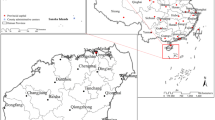Abstract
The rational allocation of medical service resources can affect the convenience of residents to obtain health care services. Therefore, the uneven distribution of medical resources is currently a prominent problem in the process of building medical and health services in China. The spatial accessibility analysis can assess areas of lack of medical resources and serve as a scientific measure for assessing the rationality of spatial allocation of medical services. This study uses the route planning module based on the online map API to calculate the distance of residents arriving at medical institutions, through the spatial accessibility analysis method based on the gravity model, and use ArcGIS to geographically visualize the results. The spatial accessibility in the northeastern part of Tianhe was much lower than that in the southwestern part, indicating that there is still a large spatial accessibility difference in medical facilities in Tianhe District, and the layout of medical facilities lacks certain rationality. Where healthcare service resources are concentrated but medical care is crowded, hospital pressure should be minimized and some patients should be referred to the surrounding areas. At the same time more medical services should be offered to improve the allocation of local medical resources where medical resources are scarce.
Access this chapter
Tax calculation will be finalised at checkout
Purchases are for personal use only
Similar content being viewed by others
References
Tao, Z., Cheng, Y.: Research progress of the two-step floating catchment area method and extensions. Prog. Geogr. 35, 5 (2016)
Song, Z., Chen, W., Yuan, F., Wand, L.: Formulation of public facility location theory framework and literature review. Prog. Geogr. 29(12), 1499–1508 (2010)
Andersen, R.M.: Revisiting the behavioral model and access to medical care: does it matter? J. Health Soc. Behav. 1–10 (1995). https://doi.org/10.2307/2137284
Comber, A.J., Brunsdon, C., Radburn, R.: A spatial analysis of variations in health access: linking geography, socio-economic status and access perceptions. Int. J. Health Geogr. 10(1), 44 (2011). https://doi.org/10.1186/1476-072x-10-44
Aday, L.A., Andersen, R.: A framework for the study of access to medical care. Health Serv. Res. 9(3), 208 (1974)
Chen, J., Hou, F.: Unmet needs for health care. Health Rep. 13(2), 23–34 (2002)
Guagliardo, M.F.: Spatial accessibility of primary care: concepts, methods and challenges. Int. J. Health Geogr. 3(1), 3 (2004)
Penchansky, R., Thomas, J.W.: The concept of access: definition and relationship to consumer satisfaction. Med. Care, 127–140 (1981). https://doi.org/10.1097/00005650-198102000-00001
Delamater, P.L.: Spatial accessibility in suboptimally configured health care systems: a modified two-step floating catchment area (M2SFCA) metric. Health Place 24, 30–43 (2013). https://doi.org/10.1016/j.healthplace.2013.07.012
Cavalieri, M.: Geographical variation of unmet medical needs in Italy: a multivariate logistic regression analysis. Int. J. Health Geogr. 12(1), 27 (2013). https://doi.org/10.1186/1476-072x-12-27
Apparicio, P., Abdelmajid, M., Riva, M., Shearmur, R.: Comparing alternative approaches to measuring the geographical accessibility of urban health services: distance types and aggregation-error issues. Int. J. Health Geogr. 7(1), 7 (2008). https://doi.org/10.1186/1476-072x-12-27
Hu, R., Dong, S., Zhao, Y., Hu, H., Li, Z.: Assessing potential spatial accessibility of health services in rural China: a case study of Donghai County. Int. J. Equity Health 12(1), 35 (2013). https://doi.org/10.1186/1475-9276-12-35
Fransen, K., Neutens, T., De Maeyer, P., Deruyter, G.: A commuter-based two-step floating catchment area method for measuring spatial accessibility of daycare centers. Health Place 32, 65–73 (2015). https://doi.org/10.1016/j.healthplace.2015.01.002
Cabrera-Barona, P., Blaschke, T., Kienberger, S.: Explaining accessibility and satisfaction related to healthcare: a mixed-methods approach. Soc. Ind. Res. 133(2), 719–739 (2017). https://doi.org/10.1007/s11205-016-1371-9
Cheng, G., et al.: Spatial difference analysis for accessibility to high level hospitals based on travel time in Shenzhen, China. Habitat Int. 53, 485–494 (2016). https://doi.org/10.1016/j.habitatint.2015.12.023
Wang, F., Xu, Y.: Estimating O-D travel time matrix by Google maps API: implementation, advantages, and implications. Ann. GIS 17(4), 199–209 (2011). https://doi.org/10.1080/19475683.2011.625977
Gu, W., Wang, X., McGregor, S.E.: Optimization of preventive health care facility locations. Int. J. Health Geogr. 9(1), 17 (2010). https://doi.org/10.1186/1476-072x-9-17
Hansen, W.G.: How accessibility shapes land use. J. Am. Inst. Planners 25(2), 73–76 (1959). https://doi.org/10.1080/01944365908978307
Joseph, A.E., Bantock, P.R.: Measuring potential physical accessibility to general practitioners in rural areas: a method and case study. Soc. Sci. Med. 16(1), 85–90 (1982). https://doi.org/10.1016/0277-9536(82)90428-2
宋正娜, 陈雯. 基于潜能模型的医疗设施空间可达性评价方法. 地理科学进展 28(6), 848–854 (2009)
Bertakis, K.D., Azari, R., Helms, L.J., Callahan, E.J., Robbins, J.A.: Gender differences in the utilization of health care services. J. Fam. Pract. 49(2), 147 (2000)
Wang, F., Luo, W.: Assessing spatial and nonspatial factors for healthcare access: towards an integrated approach to defining health professional shortage areas. Health Place 11(2), 131–146 (2005). https://doi.org/10.1016/j.healthplace.2004.02.003
Acknowledgments
The authors would like to acknowledge the reviewers and editor for their insightful and constructive comments. The presented work has been funded by the National Natural Science Foundation of China (PM. Juhua Wu, NO. 71771059), the Philosophy and Social Science Foundation of Guangzhou (PM. Juhua Wu, NO. 502170111), and the Key Laboratory of Guangdong Science and Technology Finance and Big Data Analysis (NO. 2017B030301010).
Author information
Authors and Affiliations
Corresponding author
Editor information
Editors and Affiliations
Rights and permissions
Copyright information
© 2019 Springer Nature Switzerland AG
About this paper
Cite this paper
Wu, J., Zhao, Z., Jiang, S., Tao, L. (2019). The Research on Spatial Accessibility to Healthcare Services Resources in Tianhe, Guangzhou. In: Chen, H., Zeng, D., Yan, X., Xing, C. (eds) Smart Health. ICSH 2019. Lecture Notes in Computer Science(), vol 11924. Springer, Cham. https://doi.org/10.1007/978-3-030-34482-5_9
Download citation
DOI: https://doi.org/10.1007/978-3-030-34482-5_9
Published:
Publisher Name: Springer, Cham
Print ISBN: 978-3-030-34481-8
Online ISBN: 978-3-030-34482-5
eBook Packages: Computer ScienceComputer Science (R0)




